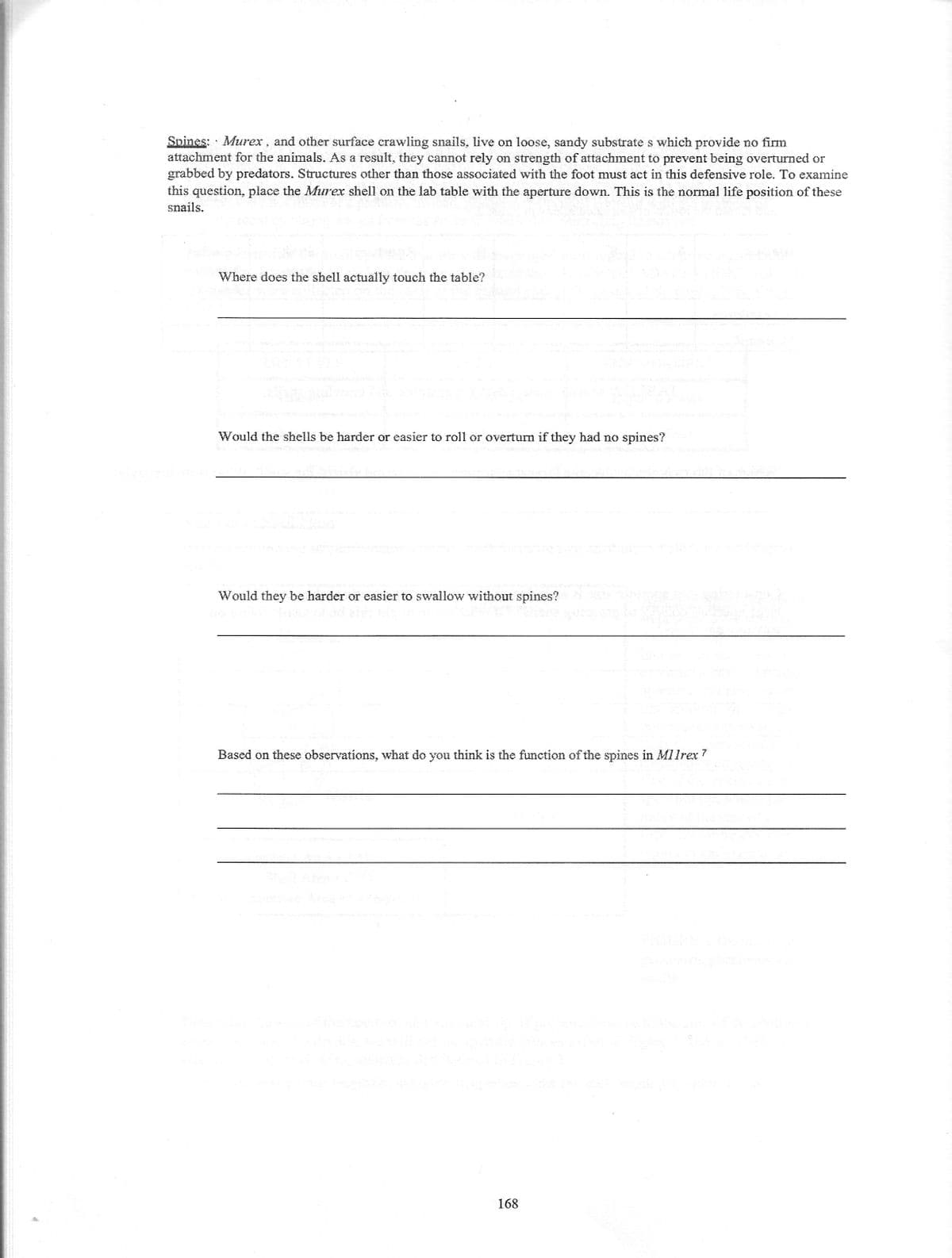Spines: Murex, and other surface crawling snails, live on loose, sandy substrate s which provide no firm attachment for the animals. As a result, they cannot rely on strength of attachment to prevent being overturned or grabbed by predators. Structures other than those associated with the foot must act in this defensive role. To examine this question, place the Murex shell on the lab table with the aperture down. This is the normal life position of these snails. Where does the shell actually touch the table? Would the shells be harder or easier to roll or overturn if they had no spines? Would they be harder or easier to swallow without spines? Based on these observations, what do you think is the function of the spines in M11rex 7
Spines: Murex, and other surface crawling snails, live on loose, sandy substrate s which provide no firm attachment for the animals. As a result, they cannot rely on strength of attachment to prevent being overturned or grabbed by predators. Structures other than those associated with the foot must act in this defensive role. To examine this question, place the Murex shell on the lab table with the aperture down. This is the normal life position of these snails. Where does the shell actually touch the table? Would the shells be harder or easier to roll or overturn if they had no spines? Would they be harder or easier to swallow without spines? Based on these observations, what do you think is the function of the spines in M11rex 7
Applications and Investigations in Earth Science (9th Edition)
9th Edition
ISBN:9780134746241
Author:Edward J. Tarbuck, Frederick K. Lutgens, Dennis G. Tasa
Publisher:Edward J. Tarbuck, Frederick K. Lutgens, Dennis G. Tasa
Chapter1: The Study Of Minerals
Section: Chapter Questions
Problem 1LR
Related questions
Question
please type out the answers.

Transcribed Image Text:Spines: Murex, and other surface crawling snails, live on loose, sandy substrate s which provide no firm
attachment for the animals. As a result, they cannot rely on strength of attachment to prevent being overturned or
grabbed by predators. Structures other than those associated with the foot must act in this defensive role. To examine
this question, place the Murex shell on the lab table with the aperture down. This is the normal life position of these
snails.
Where does the shell actually touch the table?
Would the shells be harder or easier to roll or overturn if they had no spines?
Would they be harder or casier to swallow without spines?
Based on these observations, what do you think is the function of the spines in MIlrex 7
168
Expert Solution
This question has been solved!
Explore an expertly crafted, step-by-step solution for a thorough understanding of key concepts.
Step by step
Solved in 2 steps

Recommended textbooks for you

Applications and Investigations in Earth Science …
Earth Science
ISBN:
9780134746241
Author:
Edward J. Tarbuck, Frederick K. Lutgens, Dennis G. Tasa
Publisher:
PEARSON

Exercises for Weather & Climate (9th Edition)
Earth Science
ISBN:
9780134041360
Author:
Greg Carbone
Publisher:
PEARSON

Environmental Science
Earth Science
ISBN:
9781260153125
Author:
William P Cunningham Prof., Mary Ann Cunningham Professor
Publisher:
McGraw-Hill Education

Applications and Investigations in Earth Science …
Earth Science
ISBN:
9780134746241
Author:
Edward J. Tarbuck, Frederick K. Lutgens, Dennis G. Tasa
Publisher:
PEARSON

Exercises for Weather & Climate (9th Edition)
Earth Science
ISBN:
9780134041360
Author:
Greg Carbone
Publisher:
PEARSON

Environmental Science
Earth Science
ISBN:
9781260153125
Author:
William P Cunningham Prof., Mary Ann Cunningham Professor
Publisher:
McGraw-Hill Education

Earth Science (15th Edition)
Earth Science
ISBN:
9780134543536
Author:
Edward J. Tarbuck, Frederick K. Lutgens, Dennis G. Tasa
Publisher:
PEARSON

Environmental Science (MindTap Course List)
Earth Science
ISBN:
9781337569613
Author:
G. Tyler Miller, Scott Spoolman
Publisher:
Cengage Learning

Physical Geology
Earth Science
ISBN:
9781259916823
Author:
Plummer, Charles C., CARLSON, Diane H., Hammersley, Lisa
Publisher:
Mcgraw-hill Education,